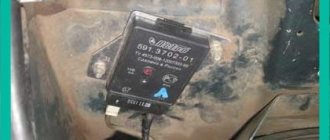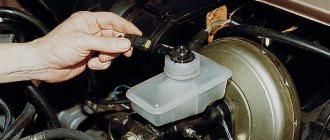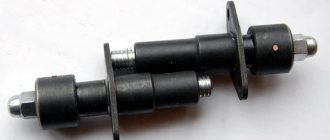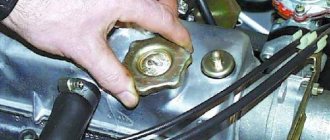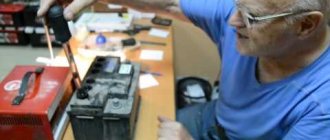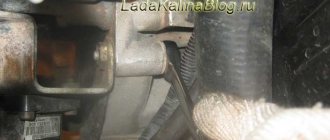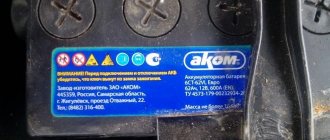The vehicle's on-board network is powered by a lead-acid battery with thick or liquid filler. The performance of the battery is affected by both normal wear and negative factors, in particular, the level and density of those components decreases. liquids. When the electrolyte level decreases, it is necessary to add liquid, depending on the measurement results. This will restore capacity and extend the life of the battery.
Adding electrolyte to the battery is necessary when its level decreases.
Why do you need to add electrolyte to the battery?
There are standards that determine the normal density of the electrolyte. The indicator is affected by the season, ambient temperature, and battery age. For example, for the central zone of the Russian Federation, a density of 1.25-1.3 g/cm3 is considered normal. If the battery is frozen or overheated, the density will most likely change, as a result the battery will discharge faster, and as a result, the car may simply not start in the morning and will not be charged from the car’s generator.
If you correctly add electrolyte to the battery, the problem will be solved, unless the reason lies in the natural wear of the battery plates or problems in the vehicle’s on-board network.
What to do with a lower electrolyte density?
So, the problem is this: the battery has stopped holding a charge. Is it worth changing it? Is it possible to add electrolyte to the battery at low density, or can the battery’s performance not be restored? The answer to this question depends on the age of the battery and the hydrometer readings when tested.
If the battery is old enough (for example, it is about 4-5 years old), then its inability to hold a charge is primarily due not even to the density of the electrolyte, but to a violation of the integrity of the plates in the battery banks. In this case, even restoring the previous density indicators will not solve the problem. However, if the battery is relatively new, the problem can be solved by adding electrolyte. The only question is whether it is necessary to fill in the electrolyte?
The average electrolyte density in a “working” battery is approximately 1.25-1.30 g/cm³. Moreover, this value should be approximately the same for each battery bank with a deviation of no more than 0.01-0.03. If the density of the electrolyte is less than 1.25, but more than 1.20, most likely adding electrolyte will help solve the problem.
We also watch a video on how to properly increase the density of the electrolyte in a battery: We also recommend reading the article on how to extend the life of a car battery. This article describes the main reasons for a short battery life, how to extend it, and signs that your battery will soon stop working.
Checking the fluid level
Notches for checking the electrolyte level.
You can determine whether electrolyte needs to be topped up in the battery by looking at the control marks on the body
batteries. The marks are located inside or outside the housing. Some battery models have a viewing window made of transparent material. The notches determine the minimum and maximum technical level. liquids. During normal operation the value is in the middle. Manufacturers prohibit the use of batteries with abnormal electrolyte levels.
If there are no notches, they do not allow you to accurately determine whether electrolyte can be added to the battery or not, a glass tube will be required for measurements. To test, you need to clean the battery from dirt and dust, unscrew the plugs, and insert the tube until it stops. Next, the other side is clamped with a finger, so that the liquid remains inside the tube.
As an alternative, you can use a folded sheet of paper for measurements, determining the level by the moistened part.
The level is determined visually. This method does not allow obtaining accurate results, but it is sufficient to ensure the operation of the battery. If the liquid is below normal, it is necessary to add distilled water or electrolyte; if it is higher, pump out the excess using a pear.
The maintenance-free battery has a sealed case where access to the banks is not provided. Accordingly, to check the electrolyte volume you will need to drill holes, which is highly not recommended.
Distillate selection
If you fill the battery with ordinary water (including collected rainwater), the active mass of the plates will very quickly become unusable. To extend battery life, use only high-quality distilled water. To check the quality, consider the simplest characteristics of the distillate:
- electrical conductivity. Distilled water, unlike ordinary water, does not conduct electricity. You can check the water by measuring the resistance with a multimeter - for distillate it will be equal to infinity;
- no traces after boiling. For the test, drop water on a clean A4 sheet or heat it on a glass surface/piece of foil. After the distillate has evaporated, there should be no halos or stains left on the surface.
Video: HOW TO ADD ELECTROLYTE OR WATER INTO THE BATTERY | WHAT NOT TO DO
What can you add to the battery?
To determine what to add to the battery, you need a special measuring device - a hydrometer. This is a glass tube with a bulb, inside of which there is a float. A scale indicating the density is applied to the outer wall.
Verification algorithm:
Checking the electrolyte level with a hydrometer.
- Charge the battery to 100%.
- After fully charging, wait 3-5 hours for the chemical reaction inside the cans to normalize.
- Unscrew the plugs (if the battery is maintenance-free, drill holes in the housing).
- Immerse the hydrometer in the jar and scoop up the electrolyte with a bulb.
- Take measurements in each section one by one.
When to recharge the battery
According to many experts, the battery is not subject to maintenance. Therefore, experts consider the question of car owners what to add to the battery irrelevant. However, this is only if it is operated under normal conditions.
This issue must be taken into account if the car owner goes to travel long distances in his car. The electrolyte contains distilled water; therefore, during the operation of the battery, it evaporates and in the event of a malfunction of the relay-regulator, the liquid may begin to turn into a vapor state.
The main points of device malfunction include:
- The appearance of steam from the filler holes.
- Battery overheating while the vehicle is running.
- The appearance of electrolyte on the battery case.
In addition, the type of battery must be taken into account. Batteries can be serviced or maintenance-free.
In the first case (when the batteries are serviced), the evaporation process will be greater; accordingly, the question of adding electrolyte or water to the battery is relevant. In maintenance-free batteries, the liquid is hermetically sealed, so during operation it rises, but only to the maximum permissible level, without going beyond the boundaries of the case, after which it falls down and precipitates. Maintenance-free batteries are closed-cycle, so they do not require solution testing.
When to add electrolyte and when to add water?
Under normal conditions, the hydrometer scale shows 1.27-1.30 g/cm3. If the density is less, it means there is a lack of sulfuric acid in the battery, if there is more distilled water. In a standard operating scenario, sulfuric acid from the electrolyte is practically not consumed, so distilled water is often poured into the jars.
It is not recommended to fill in excess fluid above the level - this can lead to the release of acid into the engine compartment.
Pure electrolyte is used both to increase the density and to completely replace the process fluid in the battery banks - the filling volume depends on the battery model.
About flushing
We noted earlier that when taking measurements, an opaque liquid can be detected. This indicates that the solution contains destroyed particles of lead plates. If you restore the battery, they must be completely removed. What to put in the battery? First you need to use distilled water. Fill all damaged jars with it, close the lid and mix thoroughly. Don't be afraid to turn the battery upside down.
This way we can better clean the insides of the jar from dirt. After mixing, pour back all the dirt. What should I put into the battery next? Let's use water again. We already know how to fill the battery with water. If after repeated mixing it does not change color, it means that we have removed all the dirt from the plates. Now you can safely pour electrolyte here and measure the density. By adjusting the water and electrolyte levels we will reach the ideal value of 1.28 grams per cubic centimeter.
Features of maintenance-free batteries
Most batteries on sale are of the maintenance-free type. This decision has both positive and negative sides. In particular, if there is a need to add electrolyte to the jars, you will need to drill the battery case, which breaks the seal and automatically voids the factory warranty. The channels are made with a sharp awl all the way to the lead electrodes. The width of the hole must be sufficient so that a hydrometer tube can be inserted inside, which is necessary to determine the density of the electrolyte and what liquid to pour into a maintenance-free battery.
If the density is normal, but the level needs to be changed, a bulb or syringe will be required. Top up, depending on the hydrometer readings, with distilled water or pure electrolyte. To ensure normal operation of the battery, the technical level. liquid should be 10-15 mm above the edge of the electrode. Thus, it will be completely immersed in liquid, even when the car is parked on a slope, as a result, normal operation is ensured, and the possibility of oxidation of the plates associated with contact with air is eliminated.
Adding electrolyte to a maintenance-free battery.
Upon completion of the procedure for topping up each battery tank, it is recommended to pump the battery, thus speeding up the mixing of acid and distilled water. The IP should be shaken carefully, and under no circumstances should it be turned on its side - this leads to sludge getting between the electrodes, which reduces the service life. The next stage is a control measurement of the level and density of the electrolyte. If there is not enough fluid, it is refilled to the normal value.
The last step is to seal the holes with sealant and fully charge the battery.
How does the electrolyte structure change?
Before we figure out what can be put into a battery, let’s consider the processes that occur inside the battery during discharge and charging. This will help avoid mistakes when adding liquid to it.
So, car batteries contain 65 percent distilled water. The rest is sulfuric acid. With this ratio, the density of the electrolyte is about 1.28 grams per cubic centimeter (error up to three percent). This is the optimal level at which the desired voltage is produced. Note that during charging the temperature of this liquid increases. This process is called electrolysis. Gas is released while the battery is charging. In this case, part of the water evaporates. The acid concentration also changes. The electrolyte density increases. At first glance this may seem like a good thing. In fact, high density results in lower battery capacity.
If we consider modern maintenance-free batteries, they have a sealed closed case. Thus, the evaporated water after charging turns into condensate. And after a while it flows back into the “jar” (these are holes in the battery). The characteristics of the solution do not change and the density remains at the same level. Such a battery can last quite a long time - up to five years or more. But if the seal of the housing is broken, the distillate level drops. This negatively affects the battery life and its capacity.
It is worth talking about one more factor, which is called sulfation of the solution. This is a process in which salts from the acid begin to settle on the lead plates themselves. This usually happens when high current is applied or when the battery is idle for a long time (two months or longer). Sulfation also leads to a decrease in battery capacity and a decrease in acid concentration. Therefore, to extend the life of the battery, you need to regularly monitor the concentration of the solution inside and, if necessary, replenish its level.
Complete electrolyte replacement
To completely replace the electrolyte in a battery, you will need to go through several steps:
The battery plugs can be unscrewed with a coin.
- Place the car on a level surface, and before turning off the power, make sure that the driver has service codes from the radio and other equipment necessary to unlock them.
- Open the hood, remove the mounting cover, remove the terminals, wipe the body from dirt, dust, and electrolyte residues.
- Unscrew the cans (for a maintenance-free battery, drill holes).
- To pump out the liquid, take a medical syringe or a rubber bulb with an extension tip attached. During the procedure, you should not turn the battery over - this will prevent sludge from getting into the plates, as a result, the possibility of a short circuit.
- When draining, it can be tilted at an angle of up to 45°, which will simplify the complete pumping out of the electrolyte.
- To completely get rid of the remaining old liquid, you need to rinse the jars several times with distilled water. Slight rocking of the battery is allowed. It will not be possible to completely wash the jars - the solution will still remain in the cavities between the electrodes.
- Pour in new clean electrolyte: level is above the top edge of the electrodes.
- Let the battery sit for 5-6 hours.
- Fully charge the battery with a current of up to 0.1 A. Duration of the procedure is 18-20 hours. To fully restore capacity, you will need to perform 2-3 low-current charge cycles.
- Carry out final charging with a current of 10% of the rated capacity of the battery.
- Check the level and density of the electrolyte, if necessary, bring the values to normal.
- Install the battery on the car and connect it to the on-board network.
Adding electrolyte to the battery normalizes battery operation, allows you to restore capacity, reduces the likelihood of plate sulfation, and eliminates premature failure. You can perform the procedure yourself at home; this does not require special equipment or knowledge.
What needs to be added
Among novice car enthusiasts, you can often hear that only electrolyte or even hydrochloric acid needs to be added to the battery. Let us examine these erroneous judgments in more detail. Let us immediately note that only electrolyte based on sulfuric acid can be poured into the battery.
Sulfuric acid is involved in the reduction and oxidation reactions that occur between the battery plates. Thanks to this interaction, an electromotive force appears. Hydrochloric acid based electrolyte is not suitable for such reactions.
To answer the question of what should be poured into the battery - electrolyte or distilled water, it is necessary to consider another question: what will evaporate first? The sulfuric acid itself does not evaporate in the electrolyte, since it is a non-volatile liquid - water evaporates.
When the engine starts, the battery produces an electric current, the strength of which can be several hundred amperes. During chemical reactions, water evaporates, which is part of the electrolyte. Also, water can evaporate when the battery is charging.
In addition, intense evaporation of water can occur if the relay regulator on the car is faulty. In this case, once the battery is fully charged, there is no charge voltage limitation, which causes increased water evaporation.
The density of the electrolyte depends on the ratio of water and sulfuric acid. As the density increases, damage to the plates and precipitation of salts may occur. Therefore, to achieve the required density, it is necessary to fill only water and not electrolyte.
But if the electrolyte density is insufficient and at very low temperatures, it can freeze and the battery will fail. Therefore, when operating a serviced battery, it is very important to monitor both the density and the electrolyte level. For a maintenance-free battery there is no such problem, since the battery is sealed and all evaporated water returns to the battery compartments.
But if you pour water from a tap, you can harm the battery. Ordinary water is not suitable for topping up, as it contains a large amount of mineral salts and various organic compounds. Therefore, distilled water should be used to top up the battery.
If there is not enough water
If the liquid in the battery compartment is below the required level, you need to measure the density of the electrolyte and add distilled water to the required level, not forgetting to control the density.
If there is no water at all
Some batteries are sold without electrolyte. This does not mean that the seller deceived the buyer and provided a low-quality product. Such batteries are called dry-charged and are sold without electrolyte. The electrolyte is usually supplied in the form of 6 bottles, connected to each other in such a way that their necks coincide with the filler holes in the battery. So, filling of electrolyte occurs conveniently, simultaneously into all jars.
During production, batteries undergo a forming process that includes charging the battery, washing it and drying it with a stream of hot air. To protect the lead plates from damage, the filler necks of the cans must be hermetically sealed with special tape or stoppers.
This battery can be stored for up to 5 years. It is not allowed to store a battery with electrolyte for more than 6 months.
Filling electrolyte in a dry-charged battery
When purchasing a battery complete with a container full of electrolyte, the procedure will be as follows:
- Work must be carried out in a special ventilated room with an air temperature of at least +20°C, using protective equipment.
- It is necessary to open a special venting hole on the battery.
- Remove the protective tape and plugs from the filler necks.
- Prepare a container containing electrolyte by first unpacking and opening it.
- Turning the battery over, insert the containers with electrolyte into the holes of the battery filler necks.
- Carefully turn the battery and container over, avoiding spillage of liquid.
- After filling the jars with electrolyte, remove the empty container.
- To completely soak and cool, you need to leave the battery for about 20 minutes.
- You need to check the electrolyte level and top up if necessary.
- During the period, no earlier than 20 minutes and no later than 2 hours after filling the electrolyte, its density is checked. It should be within 1.25 g/cm3. If the density is lower or the voltage is less than 12.5 V, then the battery must be charged.
- After preparing the battery for operation, the venting hole and the filler holes are closed.
If the electrolyte has evaporated due to improper use or storage of the battery, most likely the battery will have to be disposed of. But there are still some chances to restore the functionality of such a battery. The sooner you notice this, the greater the chance of returning such a battery to service.
Important! If you have no experience in servicing batteries, it is better to entrust this procedure to specialists. Otherwise, it may be damaged or injured.
We will proceed from the fact that the battery was in a fully charged state before it dried out. In order to restore its functionality, the battery must be discharged. To do this, fill all jars with distilled water. After filling the cans and impregnating the plates, you can begin discharging the battery. We connect the load, preferably of low power.
After the battery is discharged, you need to charge it. We do not pour out the water that was poured into the jars. We charge with low current. For example, if the charging current, which is recommended for a given type of battery, is 10% of its capacity, then the current in our case should be half of this current, that is, 5%.
When charging, you should check the density. If the process goes well, the latter should increase. The signal for the end of the charge will be the intense release of gases from the cans, the so-called “boiling” of the electrolyte. The density of the liquid should be 1.15-1.2 g/cm3. If continued charging is required, the current should be reduced.
Expert opinion
Alexey Bartosh
Specialist in repair and maintenance of electrical equipment and industrial electronics.
Ask a Question
If the liquid in the battery jars turns dark during charging, this means that the battery is damaged. In this case, there is no point in continuing the restoration process and the battery will have to be disposed of.
After reaching the required density, the liquid is drained. Instead, distilled water is poured in and the discharge-charge cycle is repeated. This process takes a long time, approximately 2 days or more. As a result of these actions, the density should not increase during charging.
Then, after all the liquid has been drained from the battery, we fill in the real electrolyte and discharge it again. To do this, we connect a small load. After a complete discharge, we charge with a low current.
When charging, pay attention to the contents of the cans and the density of the electrolyte. If the electrolyte has darkened and the jars show signs of plates falling off, then the battery will have to be disposed of. If the electrolyte is transparent, we continue charging until the density of the electrolyte in all banks is in the range from 1.25 to 1.27 g/cm3.
It is possible that the density of the electrolyte in the jars varies significantly. In order to level it, you need to repeat the charge-discharge several times. You need to discharge to 10.5 V.
What to do if there is no distilled water
The first thing that comes to mind is to buy a new bottle of distilled water at the store. But some car owners prefer to make distilled water themselves because they do not trust the quality of commercially available water.
After all, if low-quality water is poured into the battery, it will, of course, work for some time. But after a while, you may just have to throw it away. The minerals contained in this water will settle on the plates and lead to a short circuit. No one will make a claim to the seller of such a product, since a lot of time will pass and it will be impossible to prove anything.
The best way to protect yourself from low-quality goods is to purchase goods from a reputable manufacturer that guarantees the quality of its products. This can be done both in specialized stores and in online stores. Signs of quality will be customer reviews and the cost of the product.
You can get distilled water yourself at home using a distillation cube (moonshine still). In addition, you can purify water this way: pour it into a plastic bottle and keep it in the freezer for 2-3 hours. Only ice is suitable for use; any remaining water is discarded.
After preparing distilled water yourself and if you are not sure of the quality of the purchased water, you need to check its hardness level. The most correct way is to use a specialized device, a TDS meter. It can be purchased in the online store for a small price. Ideally, it should show 0 ppm; water with a reading of 10-20 ppm is allowed.
Closer to practice
If everything is clear with the definition of the problem, then the question arises: what is added to the battery - water or electrolyte? The result of measurements with a hydrometer will help with the answer: if the solution is too dense, then adding water will solve the problem. If the solution has too low a density, then you cannot do without an electrolyte.
Let's deal with water. Why is it so important to add distilled or, in extreme cases, melt water? The fact is that bottled water or tap water contains impurities that, when interacting with electricity, will at least produce sediment, and in worst cases will lead to complete deterioration of the battery. Therefore, the most purified water is necessary.
To add water, you will need an ordinary funnel, then charge the battery and re-check the density of the resulting mixture.

